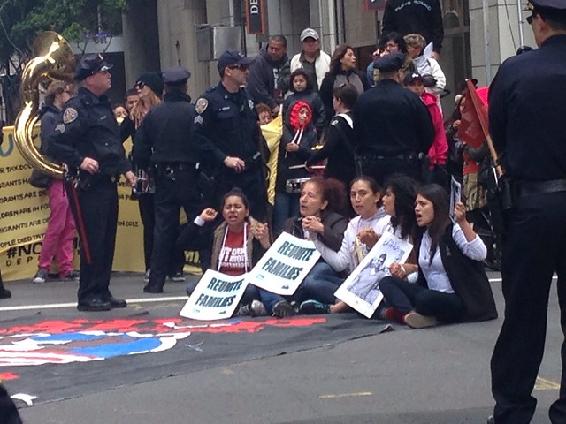9.2: Non-Citizen Populations
- Page ID
- 16091
Non-Citizens represent approximately seventeen percent of the adult prison population in California. In addition to those who are undocumented (i.e., without legal status in the United States), others are non-citizens who are legally within the United States as long-term permanent residents or on visas. Strikingly, the institutionalization rates for these non-citizen populations are significantly lower than their U.S.-born counterpart. However, given the large number of non-citizen (immigrants) in California and the complex intersections between federal immigration law and the criminal justice system, the immigrant experience in California prisons is truly distinctive. Moreover, the laws and policies discussed in this section affect not only non-citizens (whether illegal or legal) but can at times affect U.S. citizens who are perceived to be noncitizens due to their race, appearance, name, or birth abroad.

Figure 9.2 Immigration/Deportation Demonstration in San Francisco April 4, 2014. Image is under a CC.By 2.0 license.
Think about it . . . Non-Citizen Inmates
“About one in five inmates in federal prison are foreign-born, and more than 90 percent of those are in the United States illegally, according to a report compiled by the Department of Homeland Security and the Department of Justice in 2017. Some immigration experts claims that the Trump administration has inflated these number to justify a firmer stance on immigration issues. What do you think? Consult this NYT article for more information and sources and this topic.
The ongoing debate concerning immigration policy - combined with the public's fear about immigrant involvement in criminal activity and the current correctional crisis in California have led to the blending of federal immigration and national security policies with state and local correctional policies. The result is a unique set of policies and procedures that are applied to noncitizens or perceived noncitizens who enter the criminal justice system. Federal immigration enforcement programs such as the Criminal Alien Program, Secure Communities, and the 287(g) programs in most cases encourage and often rely on local authorities to work with ICE from the time of arrest throughout the criminal justice process to identify all suspected noncitizens who may be removable from the United States. In California, the Criminal Alien Program is the most extensively employed.
The Criminal Alien Program focuses on identifying "criminal aliens, who are detained in federal, state, and local facilities and seeks their removal prior to their release from criminal custody. This program begins with local police and jails collecting place-of-birth information from individuals at arrest or upon booking into jail. This information is shared with ICE's Office of Detention and Removal Operation ("DRO"), whose officers screen and interview the identified individuals. Upon the initial suspicion that an individual may be a noncitizen, including a lawful permanent resident who may be subject to removal from the United States, a "detainer" or immigration "hold" is placed on the individual, preventing his or her release until custody is transferred ICE. A person can be transferred to ICE at any point in the criminal process, even if they are not charged or convicted of an offense. In California, individuals who are convicted and sentenced and have an ICE hold placed on him or her are transferred to ICE custody after completion of their California sentence. Upon taking of custody, ICE either transports the prisoner to a detention center pending immigration proceedings or immediately removes them from the country.
In addition to these programs designed to identify "criminal aliens" for purposes of deportation, states and counties receive federal reimbursements for housing undocumented immigrants through the State Criminal Alien Assistance Program ("SCAAP"). The State of California is the largest recipient of SCAAP funds, having received upwards of $85 million through this program in recent years.
Immigrant and civil rights advocates have voiced multiple concerns regarding the increased coordination between federal agencies and state and local authorities, arguing that the blending of immigration enforcement with the criminal justice system is problematic and fraught with error. From the outset, there has been much criticism that the process of identifying potential noncitizens is laden with racial and ethnic bias, and that appearance and last names are used as proxies for citizenship to determine who should be scrutinized. In addition, critics argue that given the complexity of immigration law there is much room for error in the process of identifying potential noncitizens, and that many individuals who are actually U.S. citizens have had ICE holds placed on them. In one poignant example, Mark Lyttle, an American citizen who is bipolar, was deported after signing statements that he was a Mexican citizen, although he had a valid Social Security number. On a broader scale, immigrant and civil rights advocates contend that these federal and state partnerships have fueled anti-immigrant sentiment and the criminalization of immigrants in the media and the public at large.
Immigrant prisoners continue to be at the forefront of the political debate about the California corrections crisis. State politicians and CDCR have specifically identified the immigrant population as a way to ameliorate the overcrowding crisis facing state prisons. Following the Governor's Prison Overcrowding State of Emergency Proclamation in 2006, CDCR has prioritized the involuntary transfer of noncitizens, including those who are legal residents, to out-of-state facilities. Recently, CDCR implemented a new policy to discharge criminal aliens from state parole once deported, ensuring that should they reenter the country, they are taken into federal rather than state custody. As the immigration reform debate continues nationwide and as California continues to grapple with the overcrowding crisis in its prisons, the fate of immigrant prisoners in the California correctional system remains to be seen.

